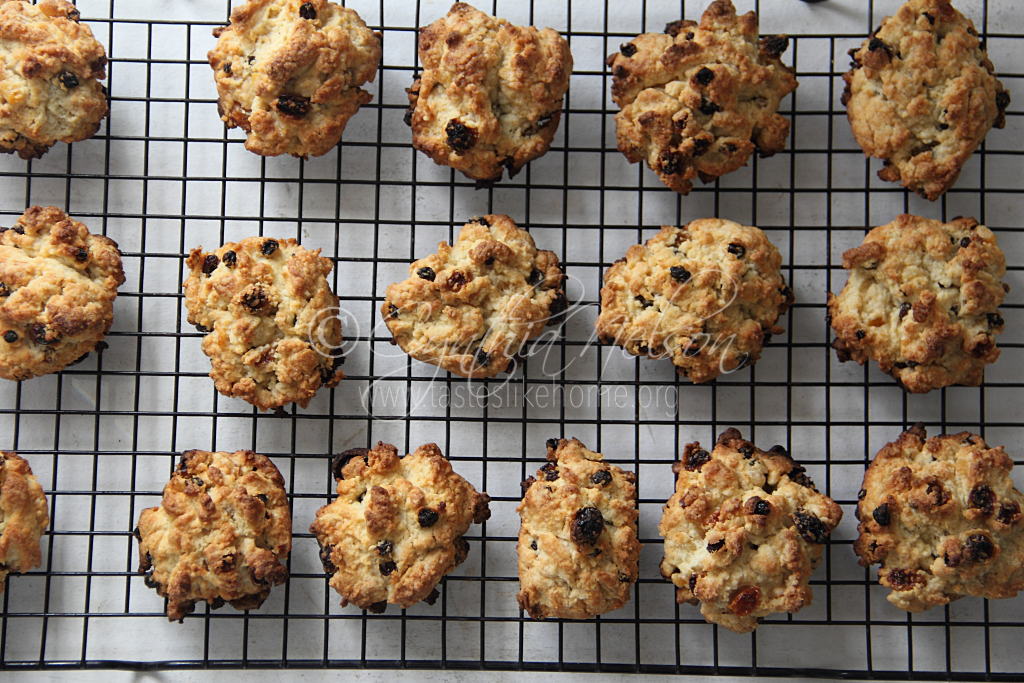
Rock Cakes did not always have the reputation for being light (in terms of texture and mouthfeel), and they still don’t, depending on yours and the baker’s preference. These cakes were born during World War II, a time for savings and rationing. The British promoted this teatime treat because it required fewer eggs and less sugar than ordinary cakes. Notice the absence of butter. Recipes for Rock Cakes consisted of flour, oats (to bulk them up), sugar, eggs, and dried fruit. No leavening agent was used, and perhaps, this also contributed to the name Rock Cake because the texture would have been firmer, dense, but nevertheless tasty. Later recipes would come to include baking powder, lard, and butter, lightening things up. By the time Rock Cakes travelled to places like our part of the world, they included ground spices like cinnamon and nutmeg and an added favourite ingredient, coconut.
A couple of weeks ago in my Column, sharing some foodie memories of my Mother, I mentioned the coconut buns I had made that she referred to as rock buns. After reading the column, some friends and I were chatting about Rock Cakes, what they are and how they like them. Each country and household has their own recipe and preferred texture and taste. For some, there must be preserved cherries, others want the bun to be very hard so that they could dunk it into their preferred hot beverage to soften it before biting into it. Some reminisced about bakeries that have since gone out of business that used to make the best Rock Cakes, while others shared that it had been years and decades since they had Rock Cakes/Buns. It is really one of those old time baking goods that’s not made as often as others are. However, when a plate of warm Rock Cakes is offered, everyone is happy to devour them.
Here in the Caribbean, each country has its own version/type of Rock Cake/Bun. If you’ve never had one, give it a try and if you are up to doing a little baking, then use this recipe for an old-fashioned Rock Cake. The method is easy and is ideal for beginner bakers. Children would find this easy to make.
I baked up a batch earlier in the week and shared it with my British neighbour and some taste testers. They were gone in no time. They are especially lovely, while warm, with tea or just as is.
ROCK CAKES
Yield: 16
INGREDIENTS
· 1¾ cups of all-purpose flour
· 2¾ teaspoons baking powder
· ¼ teaspoon fine table salt
· ½ teaspoon ground cinnamon
· 4 ounces cold unsalted butter
· ½ cup dried fruit (currants and raisins)
· 2 tablespoons citrus peel (wet candied type)
· ⅓ cup white granulated sugar
· 1 teaspoon vanilla essence/extract
· 1 large egg, room temperature
DIRECTIONS
1. Preheat the oven to 375 degrees F with the rack
in the middle.
2. Line a 13 x 18 baking sheet/pan with parchment
paper and set aside.
3. Add the flour, baking powder, salt and cinnamon
to a bowl and mix well.
4. Cut in the butter to the flour then use your fingers
to rub the butter into the flour until the mixture
resembles fine crumbs.
5. Tip in the fruits/peel and mix well to distribute
then add the sugar tossing well to mix.
6. Add the essence/extract to the egg and beat well
to mix.
7. Add half of the beaten egg mixture to the dry
ingredients and mix to combine, continue adding
the egg a little at a time only, just until the
mixture clumps together, you do not want it wet
or pasty, therefore, you may not need all of the
egg. However, if you find the mixture is still dry,
add 1 tablespoon only of milk.
8. Using forks, or 2 spoons, drop the mixture on the
baking pan in clumps about 3 inches apart.
Transfer the pan to the oven and bake for 15 to
18 minutes or until lightly brown. Let sit in the
hot pan for 2 minutes before transferring to a
wire rack to cool.
9. Serve warm or at room temperature.
NOTE
You can use self-rising flour. However, if you do, only add 1 teaspoon of baking powder to the mixture.
Enjoy!
Cynthia
cynthia@tasteslikehome.org





